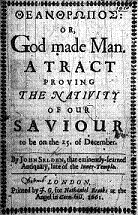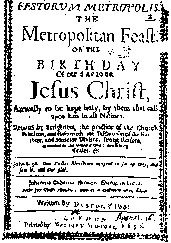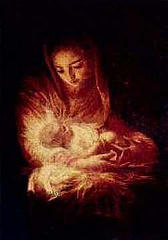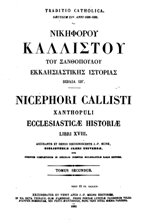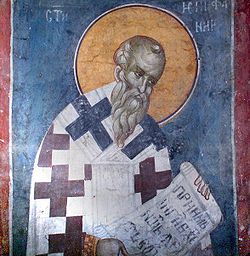Charts of Preistly Courses Explained
Following this brief introduction is a link to
charts of the priestly courses. These charts unequivocally
demonstrate that the Dec. 25th birth of Christ is
both possible and consistent with the facts in our possession.
The purpose of this introduction is to provide a brief
background so readers can better understand and interpret the
charts.
Although Solomon built the
Jerusalem temple, its pattern and service were ordained by the
hand of the Lord upon King David (I Chrn. 29:11-19). David
divided the priests into 24 courses, which served at appointed
times in the Jerusalem temple (I Chrn. 24:7-18;
cf. 28:13). The
courses were named after the family heads they represented from
the sons of Aaron. The two courses that concern us here are
Jehoiarib, the first, and Abijah, the eighth. Luke informs us
that Zechariah, the father of John the Baptist, was a member of
the course of Abijah, and was burning incense in execution of
his priestly office when Gabriel appeared and announced that his
wife would conceive a son (Luke 1:5-24). Based on statements in
Luke, John was about six months older than our Lord (Lk. 1:36,
56). Therefore, if it can once be determined when Zachariah was
serving and when John was conceived, it would be possible to
identify the approximate time of Christ’s birth 15 months later.[1] To do this we require a
point of reference from which to begin. Happily, history has not
left us without a witness. The Jerusalem Talmud records a saying
of Rabbi Yose ben Halafta, which dates to about A.D. 150 - 80
years of the event - stating that the course of Jehoiarib was
serving when the temple was destroyed by the Romans in A.D. 70:
Whence do we know that the second
Temple was also
destroyed on the 9th of Ab? We have learned in a Boraitha: “A
happy event is credited to the day on which another happy event
happened, while a calamity is ascribed to the day when another
calamity occurred;” and it was said that when the first Temple
was destroyed it was on the eve preceding the 9th of Ab, which
was also the night at the close of the Sabbath and also the
close of the Sabbatical year. The watch at the time was that of
Jehoiarib, and the Levites were chanting in their proper places,
at that moment reciting the passage [Psalms, xciv. 23]: “And he
will bring back upon them their own injustice, and in their own
wickedness will he destroy them;” and they did not have time to
end the passage, which concludes, “yea, he will destroy
them--the Lord our God,” before the enemy entered and took
possession of the Temple. This happened also at the destruction
of the second Temple.[2]
That Jehoiarib is reputed
to have been serving the 9th of Ab (August 4) when
the temple was destroyed tells us the courses were not static
and did not serve the same weeks and months year after year.
Jehoiarib being the first course could not have served in Ab,
the eleventh month, unless the courses somehow advanced
calendrically in their ranks.[3] Although
this tells us that the courses did in fact advance, it does not
tell us how they
advanced. Two basic models have emerged. The “continuous succession” model supposes that each
course followed its immediate predecessor through the 24
courses, at which point the first course began again, and so on
ad infinitum. This
model has been shown to produce results inconsistent with Jesus’
early winter birth, and therefore is not used here.[4]
The approach adopted here
is that the priestly rotations were framed within a 24-year
cycle, originally set in motion by Solomon and renewed by Ezra,
which commenced the Sabbath on or next before Tishri 1 (I Kings
8:2; II Chrn. 5:3; Ezra 7:1).[5]
Each course served one week twice annually, plus such additional
weeks necessary to fill out the year, coming in the evening of
the Sabbath (Friday) and going out the evening of the Sabbath
(Friday) following.[6]
Assuming each course advanced annually to the next station or
week in the calendar, the cycle of priestly ministration would
be completed in 24 years, at which point it would begin anew.[7]
Rabbinic tradition placing
Jehoiarib on service when the temple was destroyed allows us to
identify the station in the twenty-four-year cycle. From there
we can find when the cycle began. Then, by reckoning backward in
twenty-four-year increments to the course preceding the
conception of John the Baptist in 3 B.C., we can putatively
identify the week and month Zachariah was serving. The number of
steps from the first station of Jehoiarib’s second ministration
(for the first does not reach so far) to the week of Ab 9 is
twenty-one stations. Thus, A.D. 70 was the twenty-first year in
the twenty-four-year cycle. To return to the beginning of the
cycle we subtract twenty years from A.D. 70, which brings us to
A.D. 50. Subtracting twenty-four more years brings us to A.D.
26; this course would therefore have consisted of the years A.D.
26-49. Twenty-four more years brings us to A.D. 2; this course
would have consisted of the years A.D. 2-25. 24 years more bring
us to 23 B.C. (there was no year zero). This course would have
consisted of the years 23 B.C. to 1 A.D.
Counting forward from 23
B.C. to 3 B.C. when John was conceived shows that the course of
Abijah would have been serving at its twenty-first station when
Gabriel appeared to Zachariah (23 B.C. to 3 B.C. = 21). Assuming
Zachariah’s course was in its second ministration, this
would mean he was on duty approximately the week of Elul
28-Tishri 5 (Sept. 8-14). We do not know how long after
Zachariah’s ministration his wife conceived. Human fertility
cycles run about 28 days, during which a woman is fertile only
about 7. If we allow
that Elizabeth conceived the second week after Zechariah
returned home, this would place conception in the week of Tishri
13-19 (Sept. 22-28). Normal human gestation is 38 weeks. A
38-week gestation would place John's birth the week of Tammuz
21-27 (June 20-26), 2 B.C. Based on statements in Luke, John was
about six months older than our Lord (Lk. 1:36, 56). Six months is 26
weeks. Twenty-six weeks from John’s birth brings us to Tebet
25-Shebat 2, which answers to the week of December 22-28.
Thus, assuming the model
suggested herein is correct, rabbinic tradition regarding the
priestly courses and destruction of Jerusalem tends to
corroborate the received date of Christ's birth. The courses in
our charts are separately colored to facilitate tracking their
advancement through the calendar over the course of twenty-four
years. All dates should be taken as merely approximate.
[1]
As early as the second century, Christian writers
proposed that Zachariah was High Priest officiating on
the Day of Atonement when he received his vision. The
Day of Atonement occurred six months before Passover,
near the time of the autumnal equinox, which the Romans
set at September 24th. This would place
Jesus’ birth 15 months later about December 25th.
However, this was purely gratuitous: Zachariah was
not High Priest. The High Priest maintained a palace in Jerusalem
(John 18:15); Zachariah was from the priestly city of
Hebron in the hill country of Judea (Luke 1:39, 40;
cf. Jos. 20:7;
21:11). Even so, the very fact that men proposed
Zachariah was High Priest may reflect a tradition
connecting the priestly duties of Zachariah with the
early winter birth of Christ. Lacking technical
knowledge how to reconstruct the priestly courses to
determine when Zachariah actually served, men seem to
have resorted to the expedient that Zachariah was High
Priest officiating on the Day of Atonement instead.
[2]
Seder ‘Olam Rabbah (30.86-97). Rabbi
Yose ben Halafta is confirmed in part by Josephus who
says that the first and second temples were destroyed
upon the same day 556 years apart. Wars
6.4. 1,
5.
[3]
That the courses were not
static but advanced is also confirmed by the saying of
Rabbi Abbahu (AD 300) in Jerusalem Talmud y. Sukka
5.7-8; cf.,
Jack Finegan, Handbook of Biblical Chronology (Hendrickson, revised edition 1998),
133, §242
[4]
According to this model, the
courses may be extrapolated backward in continuous
succession from the 9th of Ab, A.D. 70, to
the relevant year to determine where any particular
course would have been serving. To do this, we multiply
365.25 days by the number of years covered, divide this
by seven to obtain the number of weeks, and then divide
this number by 24 to obtain the number of courses
fulfilled in the period. In the present case, there were
72 years between the fall of Jerusalem Ab 9, A.D. 70 and
Ab 9, 3 B.C., the year John would have been conceived.
This equals 156 complete cycles of priestly courses,
plus 13 additional weeks (365.25 x 72 = 26,298 ÷ 7 =
3,756.857 ÷ 24 = 156.53. 0.53 x 24 = 12.72). If we count
thirteen weeks before the ninth of Ab, 3 BC, this would
bring us to late April to early May. This is the point
where the first course, Jehoiarib, would have been
serving. Abijah is the eighth course, which would place
it on duty eight weeks later toward the end of June or
beginning of July. The birth of Christ 15 months later
would thus occur in late September or early October. The
courses served twice annually. Abijah would have served
again six months later near December, but this would
place Jesus’ birth toward the end of March. See also
Seldon,
Theanthropos (London, 1664), pp. 72-74.
[5]
Tishri (Sept. / Oct.) is the
Jewish New Year for accession of kings, rotation of
priests, and all things except the cycle of feasts,
which took their start with Passover in the spring.
Other sources (rabbinic, Qumran) show that the priestly
courses took Tishri 1 as their regular beginning point,
which would have no meaning under the continuous
succession model. For the rotations once set in motion, Tishri 1
could have no further significance to their progression.
It is only under a system where the courses were static
or advanced as herein proposed that recurring reference
to Tishri 1 can have any meaning. Finegan, p. 134, §§243, 246.
[6]
Josephus relates that the priests served “eight days”
from Sabbath to Sabbath. Josephus,
Antiquities,7.14.7.
[7]
Since there are 24 courses, if
they served twice annually, this will fill up 48 weeks,
leaving just less than 3 weeks remaining in the normal
lunar year, but 7-8 weeks in a leap year. The approach
taken in our tables of priestly courses is that the
extra weeks in normal years were filled by the courses
next in order (Jehoiarib, Jedaiah, and Harim), after
which the cycle advanced anew, so that, in effect, the
first three courses served three times annually.
According to Mishnayoth, Kodashim, appendix note 17:
The people were divided into twenty four divisions,
The priests, and Levites, in each formed a guard, watch
to be on Temple duty a full week every half year; and
the remaining weeks, which fell on Passover, Festival of
Weeks or Pentecost, and Feast of Tabernacles (the
so-called Pilgrim Festivals), were served by all the
divisions as all males had to be subdivided into seven
sections, each taking one day's service of the week in
turn. etc.
However, this tradition is contradicted by Josephus and
other sources which testify that the priests served from
“Sabbath to Sabbath” (Antiquities,7.14.7;f M. Sukkah 5.6-8). The seven-day week is based upon a solar year
of 365.25 days (365.25 ÷ 7 =
52 weeks).
But the feasts of the Jews followed a lunar calendar and
might occur or commence upon any given day of the week,
and therefore not correspond to the solar cycle of
“Sabbath to Sabbath.” For example, the year Jesus was
crucified, Passover occurred on a Thursday and the week
of the Unleavened bread thus run for seven days
thereafter. Since the so-called Pilgrim Festivals did
not correspond with the “Sabbath to Sabbath” solar week,
they could not possibly fill up the deficiency of
forty-eight priestly courses and a fifty-one-week lunar
year. The better view, therefore, is that the feasts did
not affect the normal progression of the courses in
their annual ministration and that the extra three weeks
were made up as proposed herein or some other way.
The assumption with leap years is that the courses whose
lot it was to be on duty in Adar each served an extra
week during the intercalated month of Adar II to allow
for the unbroken progression of the courses.
______________________________
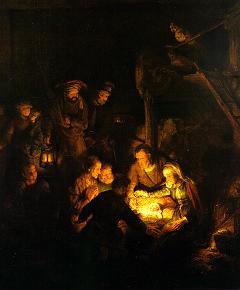
Adoration of the Shepherds
All rights reserved.
 John Seleden’s
John Seleden’s